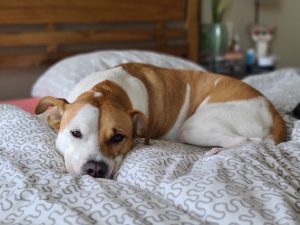9 Joshua Leggart

by Wendy Hocking & Danielle Hitch
Joshua (known to his friends as Josh) is a 35 year old man whose family have lived in Australia for many generations. He works as an office assistant in a local business, where he has been employed for approximately ten years. Josh is a keen Collingwood Football Club supporter and enjoys attending local football league games during the winter. He is currently single but was previously in a long-term relationship. Josh is a friendly and fun-loving man who loves to chat with his friends and co-workers and has a great sense of humour.
Home Life

Joshua lives with his parents (Bob, 82 and Jane, 80) in a rented property on the outskirts of a large regional town. His parents are both on an aged pension, so the family has limited income. They have lived in their rental property for over a decade, over which time the rent has increased significantly. The family now has little disposable income and limited means to participate in community activities. Their landlord does not respond to requests for repairs or maintenance on the property, which is now somewhat dilapidated. The home environment is also very messy and cluttered, as all three residents struggle with the physical and motivational demands of housework.
Josh has two brothers who live in the local area (Tom, aged 39 and Leo, aged 43). The current state of their home discourages his brothers from visiting as regularly as they used to. Josh also had a sister (Sarah) who died in a car accident when he was ten years old. Jane was driving Sarah back from dance practice at the time and subsequently developed significant depression and alcohol dependence following the accident. Bob became Jane’s primary carer while working full-time until he turned 70 years old. Josh has a dog called Chumpy, with whom he spends most of his time at home.
“Chumpy is my best mate …. he looks after me, and I look after him.”
Community

Joshua lives in a town called Bendigo, which has around 120,000 people. The town is a regional hub surrounded by farming communities and has many sporting clubs, educational institutions, cultural facilities and green spaces. The town is linked to other major population centres by train, and there are also local public bus services (although they tend to be infrequent in Josh’s local area).
Along with his immediate family, Josh has five extended family members living in Bendigo or surrounding towns. He sees them occasionally, but they are not a regular presence in this life. He completed all of his schooling in Bendigo and used to attend a hub called Creative Links, which supports people with disability to link with and participate in community activities. He stopped attending when he broke up with his former partner, a client of this service. However, he is familiar with many of the local facilities and groups from his time there. The town is very pretty, with historic buildings that bring many tourists.
“I like the big lake … especially when its sunny. There’s lots of ducks”
Health
Joshua was born with Down Syndrome, which is a genetic disorder that causes developmental and intellectual delays. His condition was identified at birth, and he was delayed in meeting developmental milestones throughout his childhood. Joshua received support from a teacher’s aide and a support worker throughout his education while completing his office administration traineeship at his current job. However, he is not receiving any additional disability support currently.
His parents know that Josh could receive assistance under the National Disability Insurance Scheme but have felt overwhelmed by their two attempts to complete their Access Request Form. As stated by Bob, “They just keep asking for more and more information, and we don’t have any updated assessments because … well, Josh is just Josh. They say he’s got special needs, but to be honest he just needs the same as everyone else”.
His family have always encouraged him to participate in life to the fullest possible degree and actively advocate for Josh whenever necessary. Before the COVID-19 pandemic, he experienced periods of feeling sad and anxious, which interfered with his daily life. His general practitioner (Dr O’Reilly) diagnosed Josh with depression, and he continues to take an anti-depressant to help with these symptoms. His current body mass index is 29 (overweight), but he has no other significant health issues. He wears glasses for all activities and has done since early childhood. Dr O’Reilly has known him since childhood and has a great rapport with him and his parents.
“I HATE exercise …. I get tired, and its SO boring.”
COVID-19
Acute Infection
Josh believes he got COVID-19 at work, but he’s unsure because many other people had it at the time. He enjoys having lunch in the staff room and talking to everyone, and someone in the room was coughing a lot. After that, many people at work got sick, and the business had to shut down for a few days due to a lack of staff. His employer arranged for everyone to do a rapid antigen test, and that’s how he found out he had COVID-19.
“I was OK, but then I got sick.”

He knew from the television that COVID-19 could be bad for old people like his parents, so he stayed alone for two weeks after his diagnosis. Josh wasn’t used to being alone when he felt sick because his mum and dad usually were very attentive. Bob left food, drink and medicine outside his bedroom door and would shout out to tell him when it was safe to come out. However, he needed to leave the bedroom to use the toilet and bathroom, as there is only one of these rooms in the house. The bathroom is very cluttered, and Josh doesn’t know how to clean it. He washed his hands with water but couldn’t find any soap. This upset him, as he likes to be clean and worried about leaving the virus in the room. When Jane also tested positive for COVID-19 two days later, Josh blamed himself. Thankfully, her infection was mild and was managed successfully at home.
Joshua largely stayed in bed the first week because he felt so sick, but he felt better in the second week and was ready to become more active. Josh loves to watch television, but there is no television in his room. This meant he could also not access his gaming console, which is also a favourite activity. Josh quickly became bored and began to experience more negative thoughts, frustration and low mood. Dr O’Reilly) maintained phone contact with the family throughout Josh and Jane’s COVID-19 infection and arranged a follow-up appointment for them as soon as they left quarantine. Both were assessed to have recovered and were back to their usual levels of function. All three members of the family had received both doses of the Pfizer vaccine along with a follow-up booster prior to their infection.
Developing Long COVID
Josh returned to work as soon as he completed his quarantine and had seen Dr O’Reilly. Most of his workmates had returned after seven days of isolation (as per the government guidelines), and they were very glad to be ‘back to normal’ and to have him back on site. Josh was happy too but felt exhausted after his first day back at work and had a terrible headache. He took a sick day the following day, and Bob arranged a telehealth appointment with Dr O’Reilly. He advised Josh he might need to take more time off work before returning to rest, as it sounded like he wasn’t ‘fully over it’. Dr O’Reilly signed him off for a week, which Josh spent mostly at home watching television and gaming. He tried to attend work again the following week but again developed a headache and even worse fatigue. Josh also experienced muscle pain and stiffness, making him uncomfortable and less willing to move around the office for tasks. He didn’t want to stay home anymore but felt his boss was getting upset with him for making mistakes or getting mixed up. Josh saw Dr O’Reilly again, who suggested he may need a longer recovery time due to his pre-existing medical conditions. Bob spoke to the employer and arranged for Josh to drop down to three days a week and work shorter hours (only in the morning) until he felt able to resume full-time duties. His boss was understanding as he said his own wife was really struggling with fatigue, and he wanted to do everything possible to keep Josh on board. However, Josh felt really bad about ‘letting him down’ and became teary and despondent at home.

Joshua and his family hadn’t really heard of Long COVID until his brother Leo mentioned it on the phone in a conversation with Bob and Jane. He said he had heard some people take longer to get better after COVID-19 so they might feel sick for a long time. Josh asked Dr O’Reilly about his next appointment, who said he wasn’t sure why some people took a long time to get over COVID-19. He had heard about it from some of his other patients. Still, he said it’s not unusual for people to be tired for a long time after viruses. He reminded Josh his genetic condition might make him more susceptible to a long recovery. When Josh asked how long he would be sick, Dr O’Reilly said he didn’t know, and there was no medicine he could give him to make him feel better. Josh was confused because Dr O’Reilly always knew how to make him feel better, and he worried that he would lose his job if he weren’t working full-time like before. While Bob, Jane and his boss tried to reassure him it would be all right in time, he didn’t really believe them.
“I have to get better. They’ll think I’m useless. They won’t want me anymore.”
Current Situation
Josh continues to feel constantly fatigued, has daily headaches most days, and his muscle pain and stiffness are now constant. He has put on seven kilograms since being diagnosed with COVID-19, and everything in life seems difficult. Given his slow recovery from the first one, Josh continues to seek Dr O’Reilly regularly, who has told them he really needs to avoid getting any further COVID-19 infections. So, he wears a mask everywhere he goes, washes his hands multiple times a day and avoids going out in the community unless it’s absolutely necessary. Any trips outside of his house are brief anyway due to his fatigue and usually result in him returning to bed upon his return. His work hours have now been reduced to two hours on two days of the week as this appears to be all he can currently manage. His work colleagues were very understanding but unsure what to say or how to help. So they avoid talking to him about it altogether. However, his boss remains supportive, which is important as Josh’s wage helps his parent to cover the family’s bills.
Bob and Jane are very worried about Josh’s health and well-being as they believe he is sleeping too much and has become depressed again. While they have a lot of empathy for their son, they are also increasingly irritated at him for not helping around the house or doing anything other than working and sleeping. As Jane says, “Sometimes its hard to know if its the COVID or if he’s just being a bit lazy and blames it on that.” However, Bob thinks “he’s putting all his efforts and energy into keeping his job, which is really important to him … and us.” Josh wishes he never got COVID-19, and he often wonders what he did ‘wrong’ in getting it. He knows he was lucky not to have to go to the hospital, but he feels like Dr O’Reilly can’t help him, so this could be his life from now on.
Life Roles
Long COVID has had a negative impact on most of Josh’s life roles. He wants to be a full-time worker again and values being a friend and community member. Josh feels particularly guilty about not being a good dog owner, as he knows Chumpy depends on him.
“He’s so sad when he doesn’t walk … and that’s my fault”
| Role | Before COVID-19 | Currently |
| Worker | Josh worked as an office assistant in a local business full time. | Continues to work in this position, but reduced hours (two hours per day on two days of the week) |
| Home Maintainer | Josh helped his parents with domestic activities such as housework, laundry and gardening. He could not complete most tasks independently but would work alongside Bob or Jane under their direction. | Not providing any assistance with domestic tasks. |
| Friend | Josh kept in touch with some friends from his time at Creative Links and occasionally met them in town after work. He also goes to football with a family friend (Jim) who also supports the local team. | He no longer sees any of his friends and cannot tolerate attending a full Australian Rules Football game (approximately three hours). Josh also worries about being exposed to COVID-19 in a crowd. |
| Family Member | Josh saw his brothers monthly at family gatherings and occasionally at their parent’s home. He would also see extended family members on a less regular basis. | His brothers no longer visit his house, as they are concerned about the risk to their own children from the clutter and dilapidation of the property. He speaks with them by phone occasionally but misses seeing them. He has not had contact with his extended family since before the pandemic. |
| Community Member | Josh regularly visited the nearby supermarket for his parents, where the staff all knew him and would always have time to chat with him. He was also friendly with the bus driver, who regularly took him to work and back. | Josh doesn’t see any of these community friends, as he no longer visits the supermarket or takes the same bus he used when working full time. |
| Pet Owner | Josh walked Chumpy twice daily and cleaned up after him in the backyard. He also attended all veterinary visits with his parents. | He no longer walks Chumpy because of his fatigue. Bob walks Chumpy when he can but can’t always do this due to other commitments. Bob also finds it hard to walk him sometimes, as Chumpy is excitable and pulls on the lead (which Josh is strong enough to manage). |
Activities of Daily Living
In addition to changes in his life roles, Long COVID has negatively impacted many of Josh’s activities of daily living.
Brushing Teeth. Photo by MART Productions from Pexels / Morning Coffee. Photo by MART Productions from Pexels / Gaming. Photo by MART Productions from Pexels
| Activity | Before COVID-19 | Currently |
| Showering / Bathing | Independent for showering, but no one uses the bathtub due to difficulties with transfers. The bathroom has a separate shower cubicle and bathtub. | Independent, but requires a rest of 10 minutes afterwards to reduce breathlessness and ‘recharge.’ |
| Eating | Independent for feeding and drinking activities. No swallowing issues. He ate the same diet as his parents, which included mostly non-processed foods. | He is Independent but has increased his intake of sugary and processed food (including high caffeine/energy drinks). He believes this helps with his fatigue but acknowledges he has put on weight recently. |
| Walking / Moving Around | Independent. Able to walk around two kilometres at a slow but steady pace, but rapidly tires after this distance due to hypotonia. | Independent, but significantly reduced endurance. Josh becomes breathless after walking to the bus stop, which is 100 metres away from his home. |
| Communication | Independent for everyday conversation. Good receptive language, particularly when plain language is used, and non-abstract concepts are being discussed. Able to express himself fluently with minimal impact on understandability for others. Josh has difficulties with auditory short-term memory and auditory processing but has developed compensatory strategies (such as writing instructions down and trying to find quiet areas for conversation). These strategies have been supported by his parents, teachers and employers for many years. | Fatigue has a significant impact on Josh’s ability to communicate, both mentally and physically. He reports finding it hard to concentrate on what other people are saying to him, and his boss reports he gets overwhelmed with instructions more readily now. His family also report that his speech is less intelligible at times, but he tends to withdraw from the conversation if asked to pronounce himself more clearly. Josh is reluctant to ask people to repeat themselves at work if they think he is stupid and can’t cope with this job. |
| Driving / Public Transport | Independent on familiar routes. Josh could catch the bus in all weather on specific routes after practising a couple of times with Bob or Jane. He needed someone to accompany him on unfamiliar routes or when catching the train to other locations for family gatherings or football matches. | Catches bus to and from work, located 20 metres from the bus stop. However, he needs to sit and rest at work / at home for 20 minutes after these journeys due to fatigue and breathlessness. He asks his parents to phone in sick to work on days of inclement weather or if he cannot find a mask. Josh waits for the next bus if he cannot get a seat or it is too crowded but feels increasingly anxious and frustrated if he misses more than one service. |
| Money Management | Independent for simple purchases with cash or ‘tap and go’. Bob manages Josh’s money and provides him with funds at request. Josh has a history of overspending, so Bob places any money not immediately needed into a separate saving account for him. Josh also contributes a third of his wages and benefits to the household bills and rent by mutual agreement with his parents. | Money management arrangements remain unchanged. Household bills and rent have increased sharply recently, and Josh’s wages are decreased due to his reduced work hours. This has resulted in there being very little discretionary income for Josh, and the family are struggling with considerable financial pressure. |
| Meal Preparation | Supportive participation with Bob or Jane. Josh assisted with cooking meals and cleaning up most days, with prompting and support from his parents. | Josh is no longer assisting with meal preparation. His parents have tried to scale back the tasks they ask him to complete and believe his lack of participation is related more to motivation than physical ability. |
| Shopping | Independent with a brief shopping list. Josh visited the nearby supermarket three times a week and collect a small list of daily needs (such as milk, bread, and eggs). He was able to transport up to two bags of shopping back home (approximately a one-kilometre walk) and assisted in putting them away in the cupboards and refrigerator. | Josh only leaves the house for work or GP appointments and no longer participates in this task. Bob now completes this activity but finds it increasingly difficult due to his age and other commitments. As a result, the family does not always have access to fresh food. |
| Healthcare | Supported participation with Bob or Jane. Josh’s parents accompany him to all healthcare appointments and advocate for him when required. | Healthcare arrangements have not changed; however, neither Josh nor his parents feel comfortable with telehealth appointments. They often have to wait more than a week for a face-to-face appointment with Dr O’Reilly. |
| Rest / Sleep | Independent. Josh maintained good sleep hygiene and regularly attained 9-10 hours of restful sleep per night. | Josh is still in bed 9-10 hours per night, but his sleep is often broken, and he now wakes up earlier. Josh also requires additional sleep during the day. These naps last two or four hours, depending on his activity level, and there may be more than one during the day. He also now takes multiple rests sitting down following bursts of activity, which last 10-20 minutes at a time. Josh often says he doesn’t understand why he is still so tired when sleeping so much. |
Josh’s Goals
Josh is usually an optimistic person, and he still hopes that he will feel better one day. However, he doesn’t believe anyone can do anything to make that happen at the moment. He would like help with the following goals:
- Return to full-time hours at work
- Not to feel so tired all the time
- Go back to the footy with Jim
- Walk Chumpy every day
Bob and Jane would also like Josh to get more help with his symptoms of depression, but he does not want to work on this at the moment.
“I just want my old life back.”
What does the evidence say?
The current body of evidence.
- Rawlings and Beail [1] note there has been very little empirical research on Long COVID in this population to date, meaning evidence-based practice can only be based on assumptions that may or may not be valid.
- There have been no studies to date on the prevalence rate of Long COVID in people with intellectual disabilities [2].
General impact of the COVID-19 pandemic.
- Clinicians working with people with intellectual disabilities during the pandemic have observed greater distress and isolation for their patients, who are already at risk of disadvantage and poor health outcomes [3]). Families often took on greater responsibility for support during lockdowns or times of restriction [4], while accessing information in plain language about public health orders and other mitigation measures was not always available [5].
Risk factors.
- Most available studies have identified a significantly increased risk of death from COVID-19 for people with intellectual disabilities in comparison to the general population [6] [7] [8] [9]. However, Turk et al. [10] reported similar mortality rates from COVID-19 between these groups.
- Several studies indicate people with intellectual disabilities (including Down Syndrome) are also at increased risk of contracting COVID-19, COVID-19-related complications (including acute respiratory distress syndrome or ARDS), a longer length of stay, hospitalisation and intensive care admission than the general population [11] [12] [13]. These increased risks have been attributed to the combined impact of immunological dysfunction, systemic inflammation, early aging and a higher incidence of respiratory infections in people with intellectual disabilities [14] [15] [16].
Working with people with intellectual disabilities experiencing Long COVID.
- Shankar et al. [17] provide an overview of the unique challenges associated with Long COVID for people with intellectual disabilities. These patients can find it hard to identify and discuss their symptoms due to cognitive and communication difficulties. Neuropsychiatric issues such as depression, anxiety, delirium and psychosis are more common in people with intellectual disabilities and may be pre-existing conditions for those contracting COVID-19. Therefore, identifying the impact of Long COVID on people with intellectual disabilities may require increased vigilance about subtle changes in behaviour, function, prescribing or support needs. Observations about these changes may be made by clinicians, carers or family members. For an overview of research priorities in this area, please see Appendix A of this article.
Available case studies or series.
- Amin et al [18]: A 42 year old woman with Down Syndrome, hypothyroidism and diabetes was admitted to a hospital in Bangladesh (n=1). Admitted to the hospital on Day 11 following infection and experienced worsening respiratory symptoms, fever, myalgia and cough over time. She remained in the hospital for 16 days and required CPAP treatment. At a three-month follow-up appointment with her community doctor, she described continuous myalgia in all limbs and joint pain, particularly in her feet. The patient had no prior history of joint or muscle pain. Painkillers and non-steroidal anti-inflammatory drugs were prescribed to manage this problem, but no other treatment was described. Along with greater attention to early identification and treatment of COVID-19 infections in people with intellectual disabilities, the authors recommend an annual musculoskeletal examination for all people with Down Syndrome be offered as standard practice.
- Perera et al. [19]: Cases of COVID-19 mortality in British and Irish people with intellectual disabilities (n=66). This cohort was younger (mean age 64 Years) than the general population and experienced higher rates of moderate-to-profound intellectual disability, epilepsy, mental illness, dysphagia, Down syndrome and dementia. Some variability was identified between groups with different severity of intellectual disability (mild-moderate-severe). The authors comment on the urgent need for further research in this area, particularly around the compounding impact of comorbidities.
Upcoming research.
- A follow-up survey for the Intellectual Disability Supplement to the Irish Longitudinal Study on Ageing (IDS-TILDA) is currently underway with specific questions regarding Long COVID in this population.
Further information.
- Eusebio, K. (April 24th, 2020). Why COVID-19 confinement is hitting people with intellectual disabilities hard | World Economic Forum (weforum.org) [20] World Economic Forum, Geneva.
- National Task Group on Intellectual Disabilities and Dementia Practices. (2022, October 5). Advisory on Long-COVID and Impact on Cognitive Function in Adults with Intellectual Disability. Available at www.the-ntg.org.
References
- Rawlings, G.H., & Beail, N. (2022). Long-COVID in people with intellectual disabilities: A call for research of a neglected area. British Journal of Learning Disabilities, early view. ↵
- Shankar, R., Perera, B., Roy, A., Courtenay, K., Laugharne, R., & Sivan, M. (2023). Post-COVID syndrome and adults with intellectual disability: Another vulnerable population forgotten? The British Journal of Psychiatry, 222(1), 1-3. doi:10.1192/bjp.2022.89. ↵
- Howkins, J., Hassiotis, A., Bradley, E., Levitas, A., Sappok, T., Sinai, A., . . . Shankar, R. (2022). International clinician perspectives on pandemic-associated stress in supporting people with intellectual and developmental disabilities. British Journal of Psychiatry Open, 8(3), E84. doi:10.1192/bjo.2022.49. ↵
- Navas, P., Verdugo, M.A., Martinez, S., Amor, A.M., Crespo, M., & Deliu, M.M. (2022). Impact of COVID-19 on the burden of care of families of people with intellectual and developmental disabilities. Journal of Applied Research in Intellectual Disabilities, 35( 2), 577– 586. https://doi.org/10.1111/jar.12969 ↵
- Embregts, P.J.C.M., Tournier, T., & Frielink, N. (2022). The experiences of psychologists working with people with intellectual disabilities during the COVID-19 crisis. Journal of Applied Research in Intellectual Disabilities, 35( 1), 295– 298. https://doi.org/10.1111/jar.12916 ↵
- Shankar, R., Perera, B., Roy, A., Courtenay, K., Laugharne, R., & Sivan, M. (2023). Post-COVID syndrome and adults with intellectual disability: Another vulnerable population forgotten? The British Journal of Psychiatry, 222(1), 1-3. doi:10.1192/bjp.2022.89. ↵
- Public Health England. COVID-19 Deaths of People Identified as Having Learning Disabilities – Summary. Public Health England, 2020 (https://www.gov.uk/government/publications/covid-19-deaths-of-people-with-learning-disabilities/covid-19-deaths-of-people-identified-as-having-learning-disabilities-summary). ↵
- Majithia, M., & Ribeiro, S.P. (2022). COVID-19 and Down syndrome: the spark in the fuel. Nature Review Immunology, 22, 404–405. https://doi.org/10.1038/s41577-022-00745-w ↵
- Williamson, E.J., McDonald, H.I., Bhaskaran, K., Walker, A.J., Bacon, S., Davy, S. ... & Kuper, H. (2021). Risks of covid-19 hospital admission and death for people with learning disability: population based cohort study using the OpenSAFELY platform. British Medical Journal, 374, n1592. doi:10.1136/bmj.n1592. ↵
- Turk, M.A., Landes, S.D., Formica, M.K & Goss, K.D. (2020). Intellectual and developmental disability and COVID-19 case-fatality trends: TriNetX analysis. Disability and Health Journal, 13(3), 100942. doi:10.1016/j.dhjo.2020.100942. ↵
- Majithia, M., & Ribeiro, S.P. (2022). COVID-19 and Down syndrome: the spark in the fuel. Nature Review Immunology, 22, 404–405. https://doi.org/10.1038/s41577-022-00745-w ↵
- Baksh, R.A., Strydom, A., Pape, S.E. , Chan, L.F., & Gulliford, M.C. (2022). Susceptibility to COVID-19 Diagnosis in People with Down Syndrome Compared to the General Population: Matched-Cohort Study Using Primary Care Electronic Records in the UK. Journal of General Internal Medicine, 37, 2009–2015. https://doi.org/10.1007/s11606-022-07420-9. ↵
- Gleason, J., Ross, W., Fossi, A., Blonsky, H., Tobias, J., & Stephens, M. (2021). The devastating impact of COVID-19 on individuals with intellectual disability in the United States. New England Journal of Medicine, March 5, doi: 10.1056/CAT.21.0051 ↵
- Majithia, M., & Ribeiro, S.P. (2022). COVID-19 and Down syndrome: the spark in the fuel. Nature Review Immunology, 22, 404–405. https://doi.org/10.1038/s41577-022-00745-w ↵
- Amin, M.A., Khan, I.I., Nahin, S., Bonna, A.S. Afrin, S., & Hawlader, M.D.H. (2022). COVID-19 hospitalisation with later long COVID in a person with Down Syndrome. Clinical Case Reports, 10, e06425. doi:10.1002/ccr3.6425. ↵
- Atkinson, T.P. (2022). Defective Immune Response to SARS-CoV-2 Immunization in Down Syndrome Correlates With Increased Susceptibility to Severe Illness With Infection. The Journal of Infectious Diseases, 226 (5), 755-756. https://doi.org/10.1093/infdis/jiac237 ↵
- Shankar, R., Perera, B., Roy, A., Courtenay, K., Laugharne, R., & Sivan, M. (2023). Post-COVID syndrome and adults with intellectual disability: Another vulnerable population forgotten? The British Journal of Psychiatry, 222(1), 1-3. doi:10.1192/bjp.2022.89. ↵
- Amin, M.A., Khan, I.I., Nahin, S., Bonna, A.S. Afrin, S., & Hawlader, M.D.H. (2022). COVID-19 hospitalisation with later long COVID in a person with Down Syndrome. Clinical Case Reports, 10, e06425. doi:10.1002/ccr3.6425. ↵
- Perera, B., Laugharne, R., Henley, W., Zabel, A., Lamb, K., Branford, D. ... & Shankar, R. (2020). COVID-19 deaths in people with intellectual disability in the UK and Ireland: descriptive study. British Journal of Psychiatry Open, 6, e123. ↵
- McCarron, M., Allen, A., McCausland, D., Haigh, M., Luus, R., Bavussantakath, F.R. ..... & McCallion, P. (2021) The impact of COVID-19 on people ageing with an intellectual disability in Ireland: Protocol for a follow-up survey. Health Research Board Open Research, 4, 95. doi: 10.12688/hrbopenres.13340.2. PMID: 34622141; PMCID: PMC8456373. ↵

